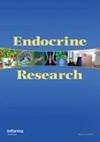The Relationship between the Lipid Accumulation Product and Beta-cell Function in Korean Adults with or without Type 2 Diabetes Mellitus: The 2015 Korea National Health and Nutrition Examination Survey
IF 1.8
4区 医学
Q4 ENDOCRINOLOGY & METABOLISM
引用次数: 3
Abstract
ABSTRACT Aims This study was conducted to assess the relationship between the lipid accumulation product index (LAP) and the homeostasis model assessment for insulin resistance (HOMA-IR) and beta-cell function (HOMA-B) in Korean adults with or without type 2 diabetes mellitus (T2DM). Materials and Methods The study was carried out using data from the 2015 Korean National Health and Nutrition Examination Survey (KNHANES) and included 4,922 adults aged 20 or older. Results There were several key findings. First, in overall population, after adjusting for related variables, HOMA-IR (p < .001) and HOMA-B (p < .001) level were positively associated with quartiles of LAP. Second, in non-T2DM group, HOMA-IR (p < .001) and HOMA-B level (p < .001) were positively associated with quartiles of LAP. Third, in T2DM group, HOMA-IR (p < .001) level was positively associated with the quartiles of LAP, but HOMA-B (p = .153) level was not significant. In addition, HOMA-B level was increased with an increasing metabolic syndrome component in non-T2DM (p < .001) but not in T2DM (p = .267). Conclusions LAP was positively associated with both HOMA-IR and HOMA-B in non-diabetic Korean adults. However, LAP was positively associated with HOMA-IR in Korean adults with T2DM, while the association with HOMA-B was not significant.韩国成人2型糖尿病患者脂质积累产物与β细胞功能的关系:2015年韩国国民健康与营养调查
【摘要】目的本研究旨在评估韩国成人2型糖尿病(T2DM)患者的脂质积累积指数(LAP)与胰岛素抵抗(HOMA-IR)和β细胞功能(HOMA-B)稳态模型评估之间的关系。材料与方法本研究使用2015年韩国国家健康与营养调查(KNHANES)的数据,包括4922名20岁及以上的成年人。结果有几个关键的发现。首先,在整体人群中,在调整相关变量后,HOMA-IR (p < 0.001)和HOMA-B (p < 0.001)水平与LAP的四分位数呈正相关。其次,在非t2dm组,HOMA-IR (p < 0.001)和HOMA-B水平(p < 0.001)与LAP四分位数呈正相关。第三,T2DM组HOMA-IR水平与LAP四分位数呈正相关(p < 0.001), HOMA-B水平与LAP四分位数呈正相关(p = 0.153)。此外,HOMA-B水平在非T2DM中随代谢综合征成分的增加而升高(p < 0.001),而在T2DM中没有升高(p = 0.267)。结论韩国非糖尿病成人LAP与HOMA-IR和HOMA-B呈正相关。然而,LAP与韩国成年T2DM患者的HOMA-IR呈正相关,而与HOMA-B的相关性不显著。
本文章由计算机程序翻译,如有差异,请以英文原文为准。
求助全文
约1分钟内获得全文
求助全文
来源期刊

Endocrine Research
医学-内分泌学与代谢
CiteScore
4.30
自引率
0.00%
发文量
10
审稿时长
>12 weeks
期刊介绍:
This journal publishes original articles relating to endocrinology in the broadest context. Subjects of interest include: receptors and mechanism of action of hormones, methodological advances in the detection and measurement of hormones; structure and chemical properties of hormones. Invitations to submit Brief Reviews are issued to specific authors by the Editors.
 求助内容:
求助内容: 应助结果提醒方式:
应助结果提醒方式:


